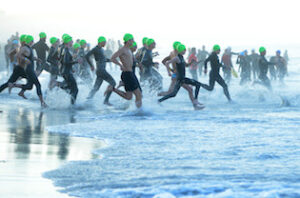Triathlon
Triathlon
 How to achieve optimum performance with the right triathlon nutrition program
How to achieve optimum performance with the right triathlon nutrition program
The triathlon is clearly one of the most physically demanding endurance sports. While all triathletes will benefit from a solid nutrition plan, if you are competing in a half or full Ironman then your nutrition plan can make all the difference in the world.
As a triathlete you know first hand how much dedication is required. The endless hours of training, developing training and racing strategies, perfecting your transition tactics and getting all of your equipment dialed in. These things are all critical to having a successful race. But with the exception of your training, nothing is more important than your nutrition. Unfortunately, nutrition is the area that many triathletes spend the least amount of time learning about. Most of the information you need is right here, and if you incorporate this knowledge into your training and racing you’re going to perform better. We recommend reading our “nutrition keys to success” to learn how hydration, energy, electrolytes, oxygen and blood sugar relates to the triathlon.
train the way you race
One of the golden rules of the triathlon is to not change things on race day. Whether you’re doing a sprint, olympic, half or full ironman, you’ll perform better if you’re taking in calories (energy) during the race, so learn how to do it in your training. Like anything, your body needs time to get acclimated to processing calories during your training and racing. In addition, with the added energy you’ll be able to train longer at a higher intensity level, thus improving your fitness level … and ultimately your performance on race day.
on-board fuel
Your body has three “on-board” full tanks and triathletes will use all thee.
– Muscle Glycogen: 1,600 calories (approx)
– Liver Glycogen: 400 calories (approx)
– Body Fat: 4,000 calories per pound of fat
Body fat is by far the largest energy store in the body, but it is more of a survival fuel than a performance fuel, and if that’s all you have left to go on you won’t be a happy triathlete … your performance will tank and you’ll feel like garbage.
You’ll easily use all of your liver glycogen, so there’s a solid 400 calories that you don’t have to worry about ingesting. Unfortunately, 400 calories is only enough to run about 4 miles!
Muscle glycogen is far and away the primary on-board full source that you will rely on and fortunately as a triathlete you will be able to tap into 100% of it … but this is still only enough to run about 16 miles. Muscle glycogen, as the name indicates, is energy that is stored in your muscles. Muscle glycogen must be used by the muscles that it is stored in. So glycogen stored in your quads is available to your quads, and so on. In other words, when your quads are running on empty they can’t “borrow” excess glycogen that may be stored in another muscle group. Since triathletes use virtually every muscle group in the body, using all of the muscle glycogen won’t be a problem. Most single sport athletes like runners and cyclists don’t enjoy this benefit as they may have large muscle groups (back, shoulders, arms, etc.) that store more energy than necessary. That’s the good news for triathletes ….
The bad news is that if you do the math, a triathlete does not come close to having enough on-board energy to compete, particularly in a half iron distance or longer.
The way that you take in your energy is different on the bike than on the run, and we have developed a detailed guide for each discipline.
on the bike …
Please refer to our detailed nutrition guide for cycling
Additional cycling nutrition notes specifically for triathletes:
Most triathletes, particularly iron distance triathletes, are very concerned about not getting enough calories in during the event. While we warn of the detrimental effects of using solid foods with fats, fibers and/or proteins in our oxygen discussion, we understand that many of you will feel the need to use energy bars or other non-liquid calories. If you choose to do this, we STRONGLY recommend doing so early on the bike after T1. The bike leg of a triathlon is often referred to as the “rolling buffet” as it is the time that triathletes tend to feast on food. The problem with solid foods is the significant length of time that it takes to digest (often 4-6 hours depending on the food) and the blood/oxygen requirements to do so. Eating in the second half of the bike leg, or worse – on the run, will leave you with food in your GI tract that your body will have a very difficult time processing. It’s a great way to get the dreaded “rot-gut” and ruin your day. Taking in easily digestible foods early on the bike, when your GI tract isn’t experiencing the additional stress of run related pounding, is the least risky time to try this. What ever you decide to do, be certain to do the same thing on your long training days to find out how your body is going to react. With the cost of triathlon entry fees these days, race day is not the time to experiment with your nutrition.
on the run …
Please refer to our detailed nutrition guide for running

